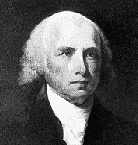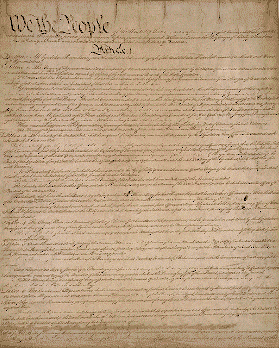 Image: James Madison was not only the preeminent figure at
the convention
Image: James Madison was not only the preeminent figure at
the conventionbut also played a leading role in the ratification process.
 The Federal Convention convened in the State House (Independence Hall) in
Philadelphia on May 14, 1787, to revise the Articles of Confederation.
Because the delegations from only two states were at first present, the
members adjourned from day to day until a quorum of seven states was
obtained on May 25. Through discussion and debate it became clear by
mid-June that, rather than amend the existing Articles, the Convention
would draft an entirely new frame of government. All through the summer,
in closed sessions, the delegates debated, and redrafted the articles of
the new Constitution. Among the chief points at issue were how much power
to allow the central government, how many representatives in Congress to
allow each state, and how these representatives should be
elected--directly by the people or by the state legislators. The work of
many minds, the Constitution stands as a model of cooperative
statesmanship and the art of compromise.
The Federal Convention convened in the State House (Independence Hall) in
Philadelphia on May 14, 1787, to revise the Articles of Confederation.
Because the delegations from only two states were at first present, the
members adjourned from day to day until a quorum of seven states was
obtained on May 25. Through discussion and debate it became clear by
mid-June that, rather than amend the existing Articles, the Convention
would draft an entirely new frame of government. All through the summer,
in closed sessions, the delegates debated, and redrafted the articles of
the new Constitution. Among the chief points at issue were how much power
to allow the central government, how many representatives in Congress to
allow each state, and how these representatives should be
elected--directly by the people or by the state legislators. The work of
many minds, the Constitution stands as a model of cooperative
statesmanship and the art of compromise. The Founding Fathers page features the biographies of the 55 delegates to the Constitutional Convention.
You can read a transcription of the complete text of the Constitution. This page also provides hyperlinks to biographies of each of the 39 delegates who signed the Constitution.
The article "A More Perfect Union" is an in-depth look at the Constitutional Convention and the ratification process.
"Questions and Answers Pertaining to the Constitution" presents dozens of fascinating facts about the Constitution.
Page two of the U.S. Constitution was unveiled in its new encasement on September 15, 2000. Read remarks issued at the ceremony by John W. Carlin, Archivist of the United States, and Dr. Michael Beschloss.
You can also display high-resolution image of each of the pages of the Constitution:
On September 17, 1787, the document was signed and sent to Congress, which soon forwarded printed copies to the state legislatures. Then began the great debate. Madison, Hamilton, and Jay wrote the brilliant Federalist Papers. George Mason, Elbridge Gerry, and Patrick Henry led the Antifederalists in opposing it. Others joined in the argument, in pamphlets, articles, speeches, and letters. By June 21, 1788, conventions in nine states later approved it. Thus the States, which had so recently gained their independence, gave up some of their hard-won sovereignty "in Order to form a more perfect Union."
 Image: James Madison was not only the preeminent figure at
the convention
Image: James Madison was not only the preeminent figure at
the convention
but also played a leading role in the ratification process.
[
Bill of Rights
|
Amendments 11-27|
Declaration of Independence
|
Charters Page
]